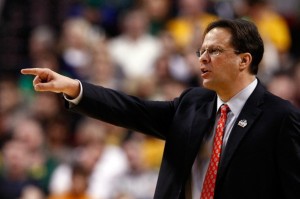Tom Crean’s Twitter Mistake Reflects Poorly on New Digital Recruiting Freedoms
Posted by Chris Johnson on August 6th, 2012Christopher Johnson is an RTC columnist. He can be reached @ChrisDJohnsonn
In response to an increasing number of maddeningly trivial secondary NCAA violations and a widespread rise in the use of smartphone-friendly forms of communication, the NCAA officially removed the coach-recruit digital contact barrier this June when its new cell phone-related recruiting rules went into effect. The new guidelines allow coaches to bombard players who have completed their sophomore year of high school with instantaneous messaging services such as texting, emailing and Twitter direct messaging. Coaches and assistants long rued the seemingly inane restrictions limiting today’s most efficient and instant forms of communication. Fewer contact controls will facilitate more frequent communication while eliminating the ever-present fear of committing a menial rule-break. Coaches can now rest easy knowing their digitized messages will safely reach a recruit’s inbox without having to regret pressing send. The result: A distinctly modernized recruiting world with streamlined communication and a newfound safeguard from the constant threat of an unsuspecting NCAA bylaw wreaking its retributive justice. The new rules makes life easier on the NCAA, too, as the organization no longer has to spend countless hours monitoring the flow of cell phone communication between coaches and recruits.

The NCAA’s new regulations allow coaches to reach recruits instantly with smartphone communication (Photo courtesy Jonathan Ferrey/Getty Images).
For the players, the long-term implications of the new contact protocol aren’t quite as rosy. Coaches that for years had wielded a restricted range of communication devices — and restricted usage on those devices — can now reach their desired prospects with the simple push of a button. The means and power to reach recruits now lies in the palm of their hands. Eliminating letters and unofficial visits in favor of texts and emails seems like a pretty fair deal for both sides, provided coaches don’t abuse their expanded degrees of communicative freedom. And therein lies the problem. In a hyper-competitive recruiting market, where coaches work tirelessly to land top high school talents, recruits can be overwhelmed by a barrage of texts and emails. Building a strong bond between player and coach is an integral aspect to any successful recruiting pitch. Now that coaches can make those connections with a few clicks on their handheld device, excessive contact is inevitable.
On Friday, Indiana coach Tom Crean provided a glimpse of what goes into the Division I college hoops recruiting pitch and brought to light another potential downside to the new guidelines. Here’s the tweet that appeared on Crean’s public feed:
“I am doing great. I have been thinking about you alot since last weekend. A whole lot. How are you doing?”
The Tweet was later deleted after Crean realized his mistake. He quickly beamed out two explanatory texts while making note of his admittedly shoddy social media skills.
Sorry. That was to a new recruit. Wish I could tell you who. Sent it by mistake. Don’t panic. Lol
— Tom Crean (@TomCrean) August 3, 2012
My wife and daughter are laughing at my lack of ability to use technology. Sorry purdue fans, it’s not what you want to think
— Tom Crean (@TomCrean) August 3, 2012
Crean apparently needs more time to adjust to the new tech-friendly recruiting rules. The NCAA allows coaches to contact recruits via Twitter direct message, yet forbids coaches from sending Tweets to prospects on public accounts. This specific measure has as its primary goal keeping communication between coach and player private. Crean’s Twitter gaffe gave his nearly 82,000 followers an up-close look into his recruiting tactics. Kentucky fans have already reached their own conclusions. Without providing some context with subsequent Tweets, Crean’s initial message may have suggested an intimate relationship, almost as if his courtship transcends basketball purposes. Clearly, that’s not the case here. But the message paints a telling portrait for the extreme lengths coaches go to find favor with targeted prospects.
Without restrictions on texting, emails and Tweets, it’s only fair to wonder if coaches — eager as they are to persuade, converse and connect with top prospects — will restrict their recruiting zeal by limiting the volume of smartphone-based communication. While the more frequent contact methods are likely to result in greater levels of understanding between coaches and players and, in turn, a decline in the number of transfers, there’s reason to fear this outwardly beneficial legislation could prove extremely bothersome for recruits, particularly ones ranked near the top of their respective classes who have dozens of coaches and assistants constantly seeking ways to gain their approval. Keeping in contact with coaches and gaining more insight about the very programs recruits may call home over the next four years is no doubt for the best. But that mutually beneficial relationship could deteriorate pretty quickly, especially if coaches feel obligated to ramp up their digital contact frequency based on rumors of wavering commitments, new suitors or indications that their desired prospects are losing interest. Occassional check-ups and casual conversations are the lifeblood exchanges that provide a measure of decorum to an overly exploitative recruiting dynamic. When contact reaches a point of intolerance for recruits — who, remember, are still just normal kids — an otherwise healthy balance runs the risk of becoming undesirably one-sided. Crean’s mistake typifies the way these new contact regulations will enable coaches to tighten the reins on coveted prospects, while also revealing the potentially disastrous ramifications of a recruiting Tweet gone wrong.












































